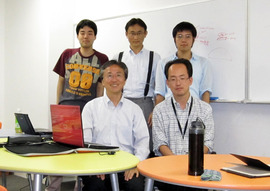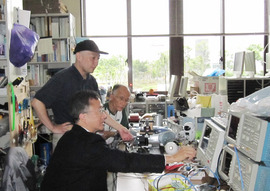Ubiquitous Communication Laboratory profile
The recent rapid growth of cell phone use has brought on the age of ubiquitous communication; we now share information any time and anywhere. Further improvement of technology will bring unimaginable new services and products, in addition to the existing services with utilizing sound, e-mail and moving images. The Ubiquitous Communication Laboratory covers various research topics including communication systems, man-machine interface, augmented reality, integrated circuit design and software development methods, to build new communication systems and computing systems from the users' point of view. In the lab, Prof. Shinichiro Haruyama works with five doctoral students and seven master's students, more than half of whom are currently working full time in the communication sector, and they can draw from their work experiences in their research. Some activities and experiments are conducted at the Kawasaki Business Incubation Center.
Robot positioning control using LED illumination
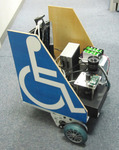
Robot positioning control with illumination
LED lights are expected to be used in most homes and offices in the future. The Ubiquitous Communication Laboratory has developed a technology to detect the accurate 3D indoor positioning by transmitting information via the visible light of LED illumination. The technology enables a robot to detect the LED light source on the ceiling two meters away and judge its position to within one centimeter. By installing the system on a wheelchair, as shown in the picture, patients can be automatically guided to an examination room in a hospital.
High accuracy surveying technology for civil engineering
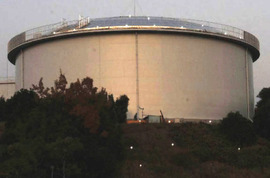
High accuracy surveying technology for civil engineering
The Ubiquitous Communication Laboratory developed “a visible light communication 3D position measurement system” jointly with Sumitomo Mitsui Construction Co., Ltd. The system, adopting visible light technology and photogrammetry for the building and construction field, enables low-cost nighttime measurement and unmanned measurement, both of which were difficult with conventional measurement technologies. The system can measure 3D positions in the range of around 40m x 40m to within a millimeter. The system was chosen as one of the “2009’s 10 greatest civil engineering innovations” by the Japan Society of Civil Engineering.
High-speed communication technology for high-speed trains
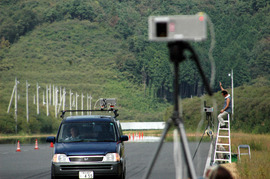
High-speed communication technology for high-speed trains
Wireless LAN internet service in trains, launched by JR Tokai in 2009, is drawing attention, but the current communication speed is slow; sending and receiving e-mail is slow and cumbersome. To enable many passengers to view video on youtube and ustream, for example, the communication speed between the ground and the train needs to be increased by several thousand times. The Ubiquitous Communication Laboratory has been conducting joint research and contract research with Railway Technical Research Institute since 2004. They have successfully developed a new technology of optical communication between the ground and high-speed moving vehicles, achieving a speed of up to one gigabit per second. The experiment on the transmission of bi-directional high-definition videos was also successful; both those on the ground and the passengers in moving vehicles were able to see high quality video without delays. The lab will continue to develop services that benefit users, including improving communication performance.
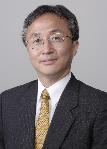 Professor Shinichiro Haruyama
Professor Shinichiro Haruyama
Professor Shinichiro Haruyama worked for AT&T Bell Labs in the US and Sony Computer Science Laboratories as researcher, and the Department of Information and Computer Science, Keio University as visiting professor. His specialties are system design for software and hardware, integrated circuits, and communication systems. He is a fellow at The Institute of Electronics, Information and Communication Engineers.
